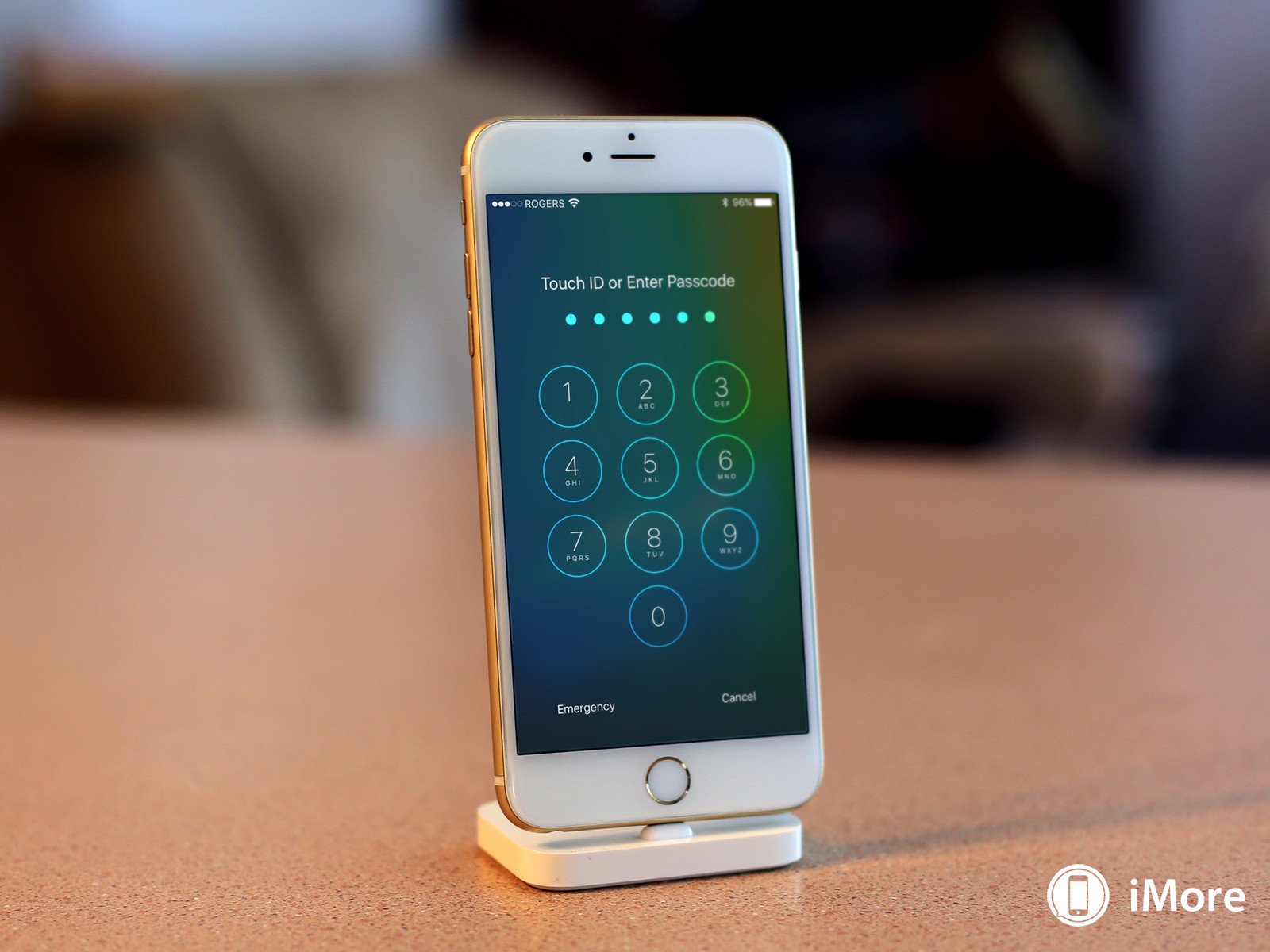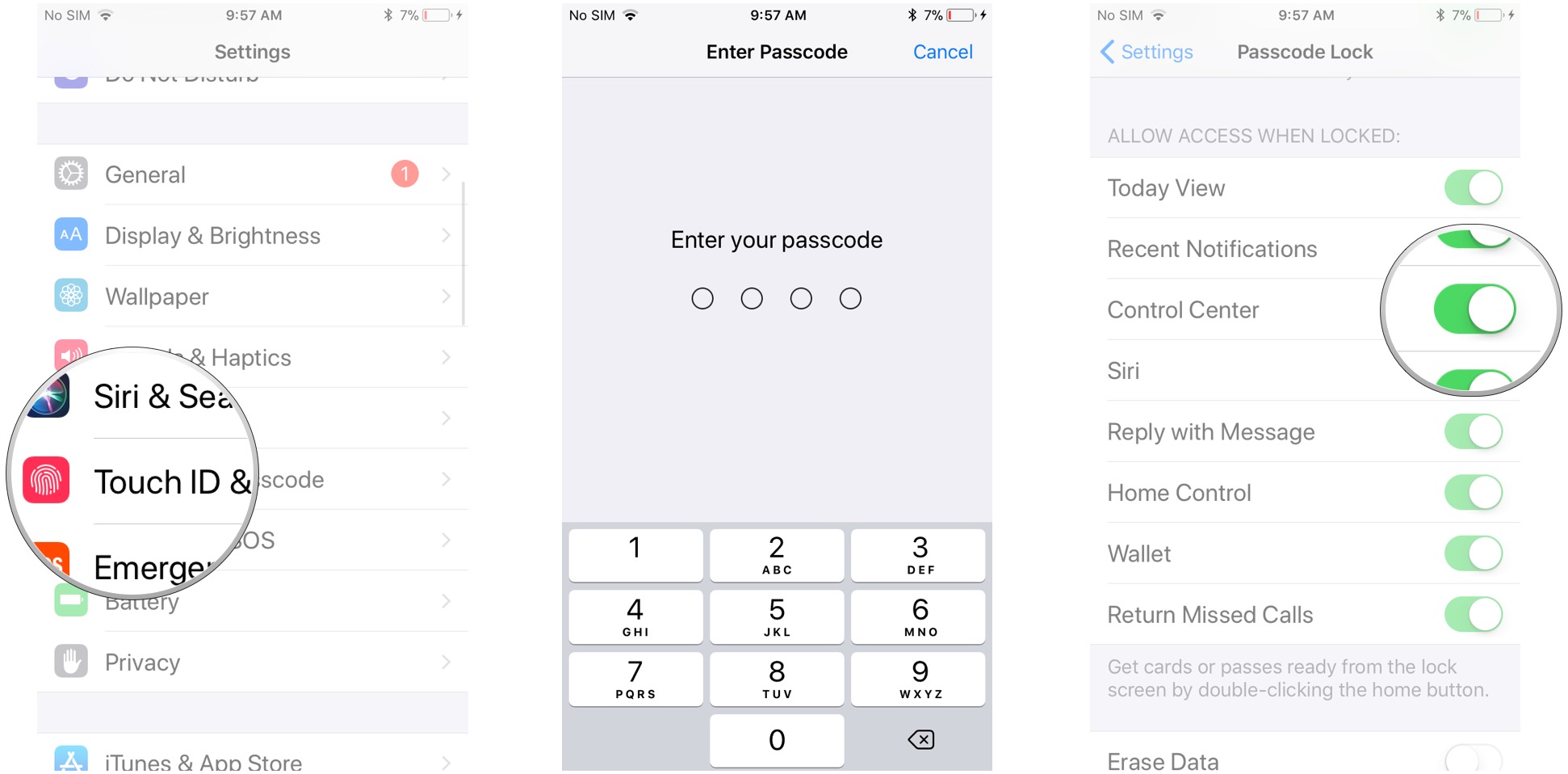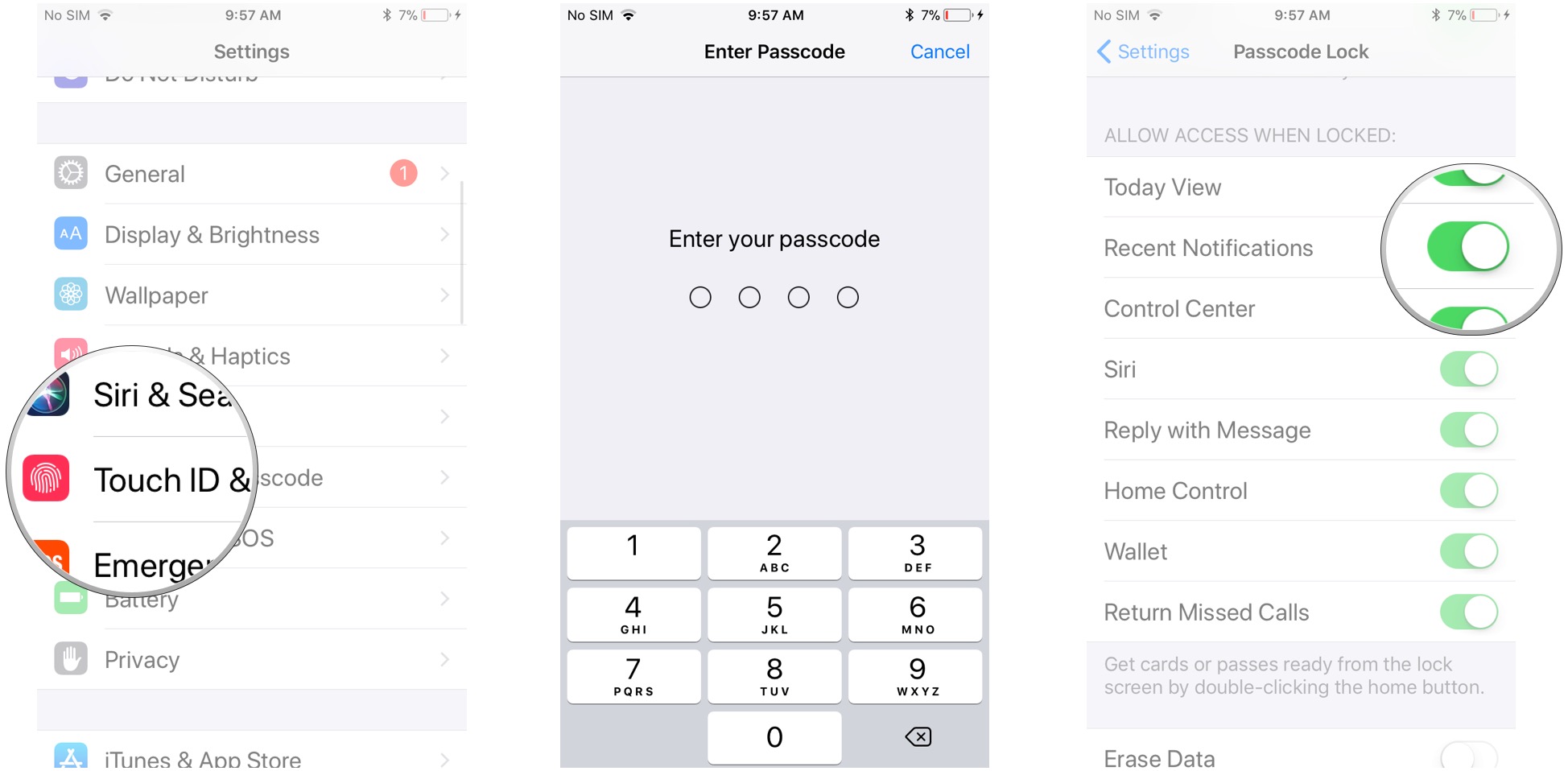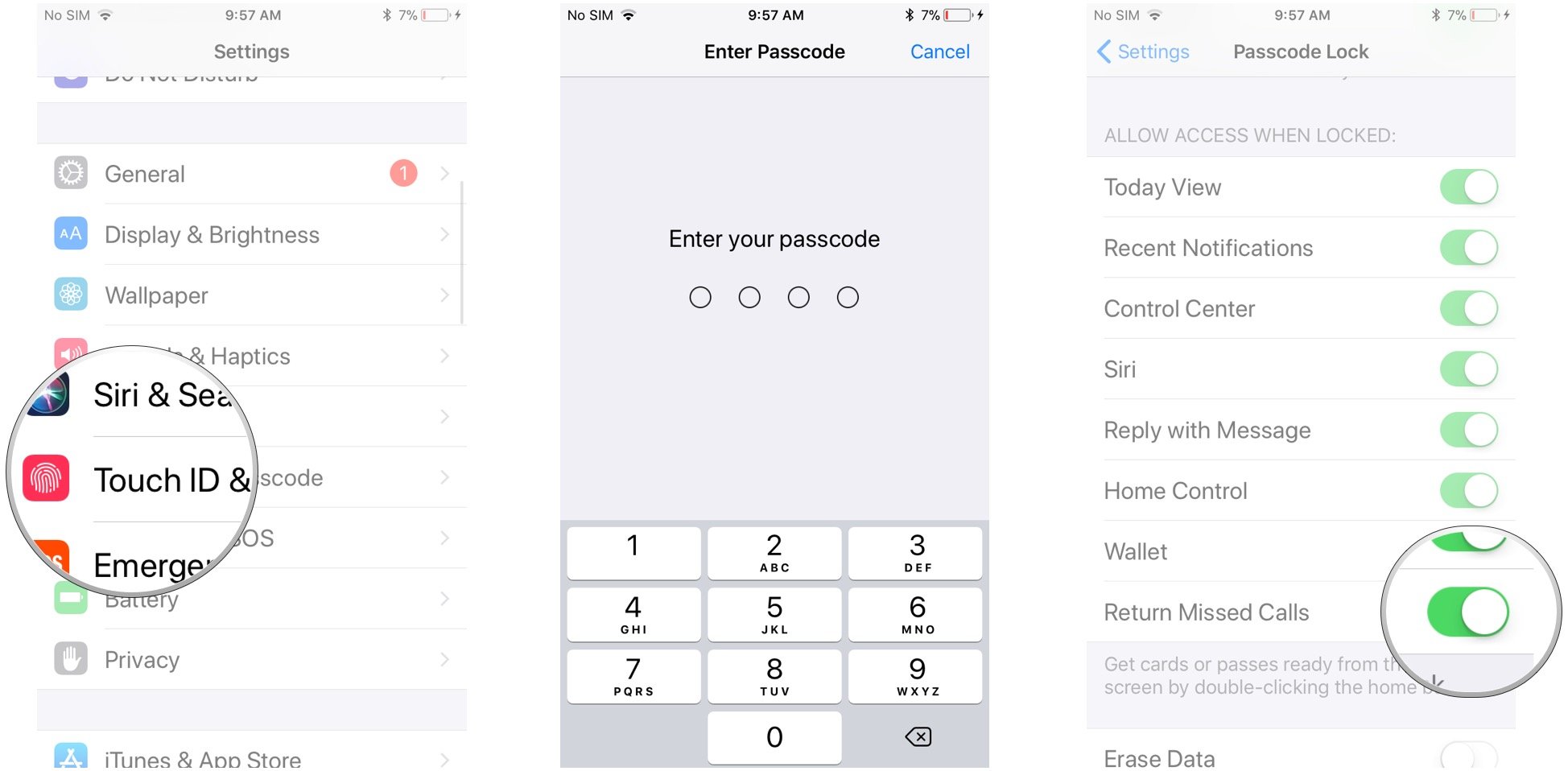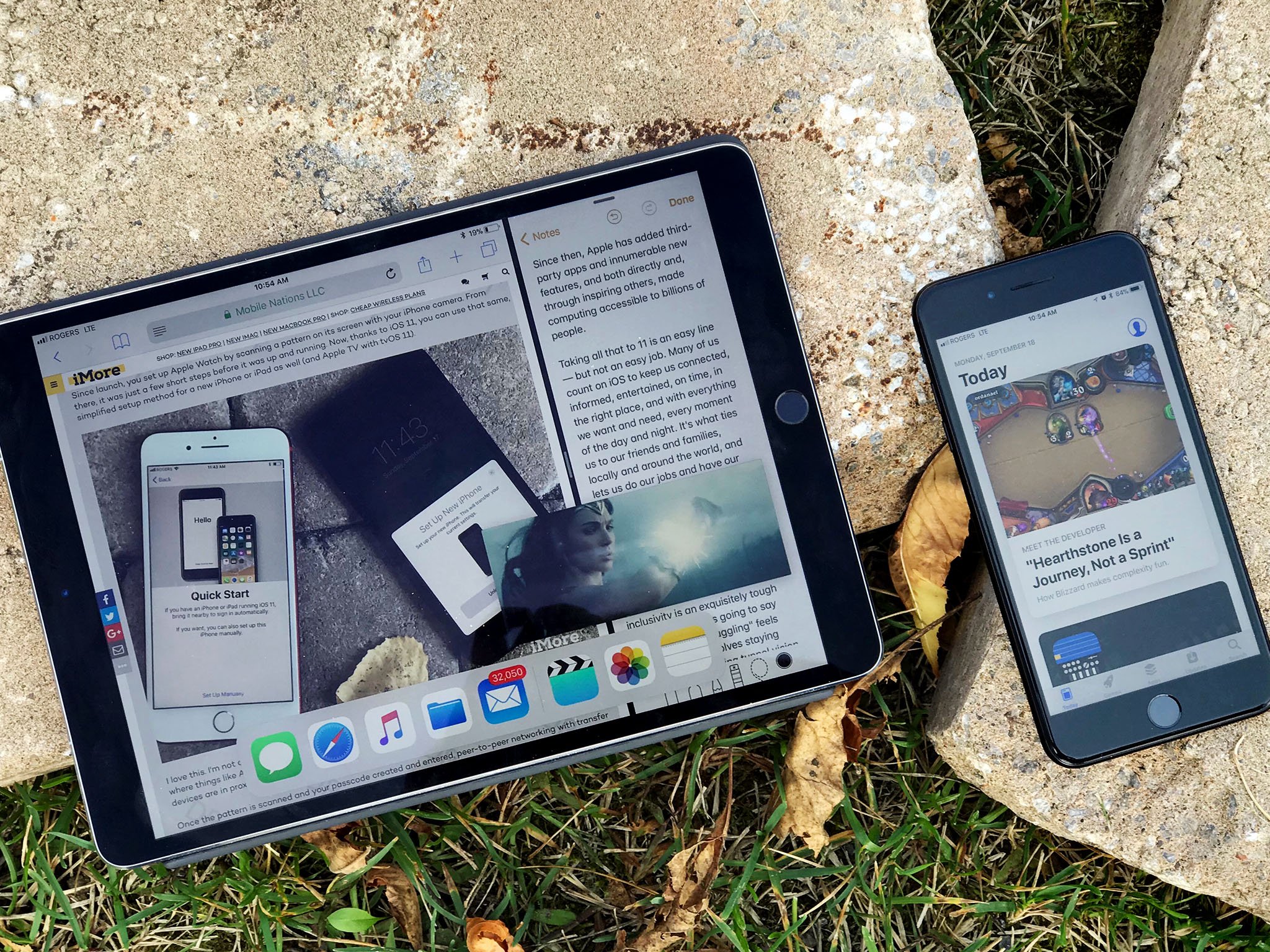How to customize your Lock screen on iPhone and iPad
- okt
- 13
- Posted by Michael
- Posted in Okategoriserade
How do you change your Lock screen wallpaper, and how do you turn off access to Siri, Notification Center, Control Center, Apple Pay? Settings makes it easy!
Lock screen serves two contradictory purposes: It provides fast, convenient access to a ton of features like the camera, Siri, Control Center, and more, and it also prevents unauthorized access to the private contents of your iPhone or iPad. You can absolutely swap your wallpaper to make it your own, but you can also disable many of the conveniences if you'd prefer your Lock screen to be on lockdown.
- How to change the wallpaper on your Lock screen
- How to set Auto-Lock time
- How to turn off Raise to Wake
- How to turn off Control Center on the Lock screen
- How to turn off notifications on the Lock screen
- How to turn off Today View on the Lock screen
- How to turn off Notification View on the Lock screen
- How to turn off Siri access from the Lock screen
- How to turn off Reply with Message from the Lock screen
- How to turn off Home Control from the Lock screen
- How to turn off Wallet and Apple Pay from the Lock screen
- How to turn off Return Missed Calls on the Lock Screen
How to change the wallpaper on your Lock screen
Your iPhone or iPad comes with Apple's default wallpaper on the Lock screen, but you can change it to another image from Apple's gallery, one of a few motion wallpapers, or even a Live Photo that animates when you 3D Touch it (if your iPhone or iPad supports it).
- Launch Settings from the Home screen.
- Tap on Wallpaper.
Tap on Choose a New Wallpaper.
- Tap on the location of the new wallpaper you want to choose:
- Dynamic: Circles that float around the screen and respond to the motion of your device.
- Stills: Apple's gallery of images.
- Live: Apple's gallery of Live Photo images that animate when you 3D Touch them.
- Libraries: All the images contained in your Photos app, including selfies, and your own Live Photos
- Tap on the image you want to use.
- If you're not happy with the default settings, adjust your options:
- Move and Scale: If it's one of your photos, you can slide it around and pinch-to-zoom in and out to frame it exactly the way you want it.
- Motion: Select if you want it still (no motion effect), perspective (moves slightly as you move your phone), or Live Photo (if available, animates on 3D Touch).
- Tap Set.
Tap Set Lock Screen if you only want to change the Lock screen wallpaper, or choose Set Both to change the Home screen wallpaper as well.
How to set Auto-Lock time
You can turn the screen off on your iPhone or iPad at any time, but by default it will turn off automatically after 2 minutes to save on power. If that time limit doesn't suit you, it's easy to change.
Note: You can't change Auto-Lock time when in Power Saver Mode.
- Launch Settings from the Home screen.
- Tap on Display & Brightness.
- Tap on Auto Lock.
- Tap on the timing you prefer:
- 30 Seconds
- 1 Minute
- 2 Minutes
- 3 Minutes
- 4 Minutes
- 5 Minutes
- Never
Tap on the Display & Brightness button at the top left to go back.
How to turn off Raise to Wake
iPhone 6s, iPhone 6s Plus, iPhone SE, and later can all automatically wake the screen when you lift them up. If you'd rather that not happen, you can disable it in Settings.
Note: Raise to Wake is only available on iPhone 6s, iPhone 6s Plus, iPhone SE, and later, running iOS 10 or later.
If you later change your mind, simply repeat the steps above and switch Raise to Wake back on.
How to turn off Control Center on the Lock screen
Control Center lets you easily access settings, media controls, and home accessories from your Lock screen. But, it also lets other people access all of that just as easily. If that's a concern, you can make it so Control Center can't be pulled up from the Lock screen.
- Launch Settings from the Home screen.
- Tap Touch ID & Passcode.
- Enter your passcode.
tap the switch next to Control Center under Allow Access When Locked. You'll have to scroll down to find it.
How to turn off notifications on the Lock screen
Having your notifications pop up on the Lock screen is incredibly convenient ... unless it reveals private and confidential information you'd rather not have revealed. It could be the name of a contact or the content of a message. Whatever the case, you can turn them off in settings. Unfortunately, only one at a time ... sigh.
- Launch Settings from the Home screen.
- Tap on Notifications
- Tap on the notification you want to disable from the Lock screen.
Switch Show on Lock Screen to Off
Repeat for any and every app whose alerts you want to keep off your Lock screen.
Note: Some apps might have additional privacy options. (e.g. for Messages, you can turn off previews.)
How to turn off Today View on the Lock screen
Today View lets you search for content, see information like news and weather, review your upcoming calendar events, see Siri suggestions, and much, much, more. If there's anything in there that's private and you don't want accessible from the Lock screen, you can turn it off.
- Launch Settings from the Home screen.
- Tap on Touch ID & Passcode.
- Enter your Passcode.
Scroll to the bottom and switch Today View to Off.
If you later change your mind, you can repeat the same steps to turn Today View back on.
How to turn off Recent Notifications on the Lock screen
As of iOS 11, you see recent notifications rather than Notification View. You can turn those off in settings.
- Launch Settings from the Home screen.
- Tap on Touch ID & Passcode.
- Enter your Passcode.
Scroll to the bottom and switch Recent Notifications to Off under Allow Access When Locked.
If you later change your mind, you can repeat the same steps to turn Notification View back on.
How to turn off Siri access from the Lock screen
Siri, Apple's virtual personal assistant, can answer questions and execute commands right from the Lock screen. Many require Touch ID or Passcode to authorize from the Lock screen, but if you'd prefer that Siri not be accessible at all, you can turn it off.
- Launch Settings from the Home screen.
- Tap on Touch ID & Passcode.
- Enter your Passcode.
Scroll to the bottom and switch Siri to Off.
If you later change your mind, you can repeat the same steps to turn Siri back on.
How to turn off Reply with Message from the Lock screen
If someone sends you a voice message (soundbite) from iMessage, and the notification pops up on your Lock screen, you can reply straight from the Lock screen. If you'd rather that not be available to pranksters and miscreants, you can turn it off.
- Launch Settings from the Home screen.
- Tap on Touch ID & Passcode.
- Enter your Passcode.
Scroll to the bottom and switch Reply with Message to Off.
If you later change your mind, you can repeat the same steps and turn Reply with Message back on.
How to turn off Home Control from the Lock screen
HomeKit lets you control your home automation accessories, even from the Lock screen. If you consider that to be too much of a security risk, you can disable it.
- Launch Settings from the Home screen.
- Tap on Touch ID & Passcode.
- Enter your Passcode.
Scroll to the bottom and switch Home Control to Off.
If you later change your mind, you can repeat the same steps and turn Home Control back on.
How to turn off Wallet and Apple Pay from the Lock screen
Wallet on your Lock screen means everything from your boarding pass to Starbucks card to movie tickets can pop up when the time and place is right. It also means your Apple Pay credit and debit cards are just a double-click of the Home screen away. If either of those things aren't to your liking, though, you can turn them off.
- Launch Settings from the Home screen.
- Tap on Touch ID & Passcode.
- Enter your Passcode.
Scroll to the bottom and switch Wallet to Off.
If you later change your mind, you can repeat the same steps to turn Wallet and Apple Pay back on.
Note: You can also control this from Settings > Wallet & Apple Pay >, and how you set one will be reflected into the other.
How to turn off Return Missed Calls on the Lock Screen
- Launch Settings from your Home screen.
- Tap Touch ID & Passcode.
- Enter your passcode.
Tap the switch next to Return Missed Calls under Allow Access When Locked.
Any Lock screen questions?
If you have any trouble setting up your Lock screen just the way you like it, or you need more help, drop your questions in the comments below!
Senaste inläggen
- Apple’s May 7 iPad Pro and Air event won’t include the rumored AI announcement, and nor should it
- New iOS 18 leak hints at AI improvements to Siri and Spotlight ahead of expected WWDC debut
- ”I can’t wait for people to see it” — Severance star says we won’t have to wait ”too much longer” for the hotly anticipated season 2 debut
- Who needs CarPlay and Siri? Tesla is reportedly working on its own in-car voice assistant instead
- Apple’s iPad dilemma — Cupertino needs new iPads more than you do
Senaste kommentarer
Arkiv
- maj 2024
- april 2024
- mars 2024
- februari 2024
- januari 2024
- december 2023
- november 2023
- oktober 2023
- september 2023
- augusti 2023
- juli 2023
- juni 2023
- maj 2023
- april 2023
- mars 2023
- februari 2023
- januari 2023
- december 2022
- november 2022
- oktober 2022
- september 2022
- augusti 2022
- juli 2022
- juni 2022
- maj 2022
- april 2022
- mars 2022
- februari 2022
- april 2021
- mars 2021
- januari 2021
- december 2020
- november 2020
- oktober 2020
- september 2020
- augusti 2020
- juli 2020
- juni 2020
- maj 2020
- april 2020
- mars 2020
- februari 2020
- januari 2020
- december 2019
- november 2019
- oktober 2019
- september 2019
- augusti 2019
- juli 2019
- juni 2019
- maj 2019
- april 2019
- mars 2019
- februari 2019
- januari 2019
- december 2018
- november 2018
- oktober 2018
- september 2018
- augusti 2018
- juli 2018
- juni 2018
- maj 2018
- april 2018
- mars 2018
- februari 2018
- januari 2018
- december 2017
- november 2017
- oktober 2017
- september 2017
- augusti 2017
- juli 2017
- juni 2017
- maj 2017
- april 2017
- mars 2017
- februari 2017
- januari 2017
- december 2016
- november 2016
- oktober 2016
- september 2016
- augusti 2016
- juli 2016
- juni 2016
- maj 2016
- april 2016
- mars 2016
- februari 2016
- januari 2016
- december 2015
- november 2015
- oktober 2015
- september 2015
- augusti 2015
- juli 2015
- juni 2015
- maj 2015
- april 2015
- mars 2015
- februari 2015
- januari 2015
- december 2014
- november 2014
- oktober 2014
- september 2014
- augusti 2014
- juli 2014
- juni 2014
- maj 2014
- april 2014
- mars 2014
- februari 2014
- januari 2014
Kategorier
- –> Publicera på PFA löp
- (PRODUCT) RED
- 2015
- 25PP
- 2nd gen
- 32gb
- 3D Touch
- 3D-kamera
- 4k
- 64gb
- 9to5mac
- A10
- A9X
- Aaron Sorkin
- Accessories
- adapter
- AirPlay
- AirPods
- Aktiv
- Aktivitetsarmband
- Aktuellt
- Alfred
- AMOLED
- Android Wear
- Angela Ahrendts
- Ångerätt
- announcements
- Ansiktsigenkänning
- app
- App Store
- Appar
- Apple
- Apple Beta Software Program
- Apple Book
- Apple CarPlay
- Apple Event
- Apple iMac
- Apple Mac Mini
- Apple Macbook
- Apple MacBook Air
- Apple MacBook Pro
- Apple Macos
- Apple Maps
- Apple Music
- Apple Music Festival
- Apple Music Radio
- Apple Offer
- Apple Online Store
- Apple Park
- Apple Pay
- Apple Pencil
- Apple Podcast
- Apple Store
- Apple Store 3.3
- Apple TV
- apple tv 4
- Apple TV 4K
- Apple Watch
- Apple Watch 2
- Apple Watch 8
- Apple Watch 9
- Apple Watch Apps
- Apple Watch SE
- Apple Watch Series 2
- Apple Watch Sport
- Apple Watch Ultra
- AppleCare
- AppleTV
- Application
- Applications
- Apps
- AppStore
- Apptillägg
- Apptips
- AppTV
- April
- Arbetsminne
- armband
- Art Apps
- Återköp
- återvinning
- Åtgärdsalternativ
- atvflash
- Audio Apps
- Augmented REality
- Back-to-school
- Bakgrundsbilder
- BankId
- Barn
- Batteri
- batteriskal
- batteritid
- Beats
- Beats 1
- Beats Solo 2 Wireless
- Beats Solo2
- Bebis
- Beginner Tips
- Belkin
- Bendgate
- beta
- Beta 3
- betaversion
- betaversioner
- bilddagboken.se
- bilder
- bilhållare
- billboard
- Bioteknik
- Blendtec
- Bloomberg
- Bloons TD 5
- Bluelounge
- Bluetooth
- Böj
- Booking.com
- Borderlinx
- bose
- bugg
- Buggar
- Buggfixar
- Butik
- C More
- Calc 2M
- Camera
- Campus 2
- Canal Digital
- Carpool Karaoke
- Caseual
- Catalyst
- CES 2015
- Chassit
- Chip
- Chrome Remote Desktop
- Chromecast
- citrix
- clic 360
- CNBC
- Connect
- Cydia
- Dagens app
- Dagens tips
- Damm
- Danny Boyle
- Data
- datamängd
- Datorer
- Datortillbehör
- Datum
- Defense
- Dekaler
- Designed by Apple in California
- Developer
- Development
- Digital Inn
- Digital Touch
- Digitalbox
- DigiTimes
- Direkt
- Discover
- display
- DisplayMate
- Dive
- Docka
- Dräger 3000
- Dropbox
- Droples
- DxOMark
- E-post
- earpod
- EarPods
- Earth Day
- Eddie Cue
- eddy cue
- Educational Apps
- Ekonomi
- Ekonomi/Bransch
- El Capitan
- Elements
- ElevationLab
- Elgato Eve
- Elgato Eve Energy
- EM 2016
- Emoji
- emojis
- emoticons
- Enligt
- EU
- event
- Eventrykten
- EverythingApplePro
- Faceshift
- facetime
- Fäste
- Featured
- Features
- Feng
- Film / Tv-serier
- Filmer
- Filstorlek
- Finance Apps
- Finder For AirPods
- Finland
- FireCore
- Fitbit
- Fitness Accessories
- Fjärrstyr
- Flurry
- Födelsedag
- fodral
- Förboka
- Force Touch
- förhandsboka
- Första intryck
- Forumtipset
- foto
- FoU (Forskning och Utveckling)
- Fource Touch
- Foxconn
- FPS Games
- Framtid
- Fre Power
- Frontpage
- Fullt
- Fuse Chicken
- Fyra
- Gadgets
- Gagatsvart
- Gamereactor
- Games
- Gaming
- Gaming Chairs
- Gästkrönika
- General
- Gigaset
- Gitarr
- Glas
- GM
- Google Maps
- Google Now
- gratis
- grattis
- Guide
- Guider
- Guider & listor
- Guld
- hack
- Halebop
- hållare
- Hälsa
- Hårdvara
- HBO
- HBO Nordic
- Health
- Health and Fitness
- Health and Fitness Apps
- Hej Siri
- Helvetica Neue
- Hemelektronik
- Hemknapp
- Hemlarm
- Hermes
- Hitta min iphone
- Hjärta
- högtalare
- HomeKit
- HomePod
- hörlurar
- htc
- Hue
- Humor
- i
- I Am A Witness
- IBM
- iBolt
- iBomber
- iBook
- icar
- iCloud
- iCloud Drive
- iCloud Voicemail
- iCloud.com
- iDevices
- IDG Play
- idownloadblog
- iFixit
- ikea
- iKörkort
- iLife
- Illusion Labs
- iMac
- IMAP
- iMessage
- iMessages
- iMore Show
- Incipio
- InFuse
- Inspelning
- Instagram-flöde
- Instrument
- Intel
- Internet/Webbtjänster
- iOS
- iOS 10
- iOS 12
- iOS 17
- iOS 18
- iOS 5
- iOS 7
- iOS 8
- iOS 8 beta
- iOS 8.1.3
- iOS 8.2
- iOS 8.3
- iOS 8.4
- iOS 8.4.1
- iOS 9
- iOS 9 beta 4
- iOS 9.1
- iOS 9.1 beta 2
- iOS 9.2
- iOS 9.2.1
- iOS 9.3
- IOS Games
- ios uppdatering
- ios9
- iPad
- iPad Accessories
- iPad Air
- iPad Air 2
- iPad Air 3
- iPad Apps
- iPad Mini
- iPad mini 4
- iPad Mini 6
- iPad mini retina
- iPad Pro
- iPados
- iphone
- iPhone 12
- iPhone 14
- iPhone 14 Pro
- iPhone 15
- iPhone 16
- iPhone 17
- iPhone 5
- iPhone 5S
- iPhone 5se
- iPhone 6
- iphone 6 plus
- iPhone 6c
- iPhone 6s
- iPhone 6S plus
- iPhone 7
- iPhone 7 display
- iPhone 7 Plus
- iPhone 7s
- iPhone Accessories
- iPhone Apps
- iPhone SE
- iphone x
- iPhone XS
- iPhone XS Max
- iPhone7
- iPhoneGuiden
- iPhoneguiden.se
- iPhones
- iPod
- iPod Nano
- iPod shuffle
- ipod touch
- iSight
- iTunes
- iWatch
- iWork
- iWork för iCloud beta
- Jailbreak
- James Corden
- Jämförande test
- Jämförelse
- Jet Black
- Jet White
- Jönssonligan
- Jony Ive
- Juice Pack
- Juridik
- Just mobile
- kalender
- kalkylator
- Kamera
- Kameratest
- Karriär/Utbildning
- Kartor
- Kevin Hart
- keynote
- Keynote 2016
- KGI
- KGI Security
- Kina
- Klassiskt läderspänne
- Kod
- Kollage
- koncept
- konceptbilder
- köpguide
- krasch
- Krascha iPhone
- Krönika
- Kvartalsrapport
- Laddhållare
- laddningsdocka
- Laddunderlägg
- läderloop
- lagar
- Lagring
- Lajka
- Länder
- lansering
- laserfokus
- Layout
- leather loop
- LG
- Liam
- Lifeproof
- Lightnigport
- lightning
- Linux
- LinX
- live
- Live GIF
- Live Photos
- Live-event
- Livsstil
- Ljud & Bild
- Logitech
- LOL
- Lösenkod
- Lösenkodlås
- Lovande spel
- LTE
- Luxe Edition
- M3
- M3TV
- Mac
- Mac App Store
- Mac Apps
- Mac Mini
- Mac OS
- Mac OS X
- Mac OS X (generellt)
- Mac OS X Snow Leopard
- Mac Pro
- Macbook
- Macbook Air
- Macbook Pro
- Macforum
- Macintosh
- macOS
- Macs
- MacWorld
- Made for Apple Watch
- magi
- Magic
- MagSafe
- Martin Hajek
- matematik
- Meddelanden
- Media Markt
- Medieproduktion
- Mediocre
- Messaging Apps
- Messenger
- MetaWatch
- Mfi
- Michael Fassbender
- microsoft
- Mikrofon
- Minecraft
- Ming-Chi Kuo
- miniräknare
- minne
- Mixer
- Mixning
- Mjukvara
- mobbning
- Mobile Content
- Mobilt
- Mobilt/Handdator/Laptop
- Mobiltelefon
- Mockup
- Mophie
- mors dag
- moto 360
- Motor
- MTV VMA
- multitasking
- Music
- Music Apps
- Music, Movies and TV
- Musik
- Musikmemon
- MW Expo 2008
- native union
- Nätverk
- Navigation Apps
- nedgradera
- Netatmo Welcome
- Netflix
- Netgear Arlo
- News
- Niantic
- Nike
- Nikkei
- Nintendo
- Nöje
- Norge
- Notis
- Notiscenter
- nya färger
- Nyfödd
- Nyheter
- Officeprogram
- Okategoriserade
- OLED
- omdöme
- Omsättning
- OS X
- OS X El Capitan
- OS X Mavericks
- OS X Yosemite
- Outlook
- Övrig mjukvara
- Övrigt
- PanGu
- papper
- patent
- PC
- pebble
- Pebble Smartwatch
- Pebble Steel
- Pebble Time
- Pebble Time Steel
- Persondatorer
- Petter Hegevall
- PewDiePie
- Philips
- Philips Hue
- Phones
- Photoshop
- Planet of the apps
- Plex
- Pluggar
- Plus
- Plusbox
- Podcast
- Podcast Apps
- Pokemon
- Pokemon Go
- Policy
- Porträttläge
- PP
- Pris
- priser
- problem
- Problems
- Productivity Apps
- Program
- Prylar & tillbehör
- Publik
- publik beta
- QuickTime
- räkenskapsår
- räkna
- ram
- RAM-minne
- Rapport/Undersökning/Trend
- Rea
- Reading Apps
- recension
- Red
- reklaamfilm
- reklam
- reklamfilm
- reklamfilmer
- rekord
- Rendering
- reparation
- Reportage
- Reptest
- ResearchKit
- Retro
- Review
- Ring
- Ringa
- Rocket Cars
- Rosa
- Rumors
- Rumours
- RunKeeper
- rykte
- Rykten
- Safir
- Säkerhet
- Säkerhetsbrist
- Samhälle/Politik
- samsung
- Samtal
- San Francisco
- SAP
- security
- Series 2
- Servrar
- Shigeru Miyamoto
- Sia
- Siri
- SJ Min resa
- skal
- Skal iPhone 6
- skal iPhone 6s
- skärm
- SKärmdump
- Skärmglas
- Skribent
- skribenter medarbetare
- Skriva ut
- skruvmejsel
- skydd
- Skyddsfilm
- Skype
- slice intelligence
- Smart
- smart hem
- Smart Home
- Smart Keyboard
- Smart klocka
- Smart Lights
- smartphone
- Smartwatch
- Snabbt
- Snapchat
- Social Apps
- Software
- Solo2
- sommar
- Sonos
- Sony
- soundtouch
- Space Marshals
- spår
- Speakers
- Special Event
- Spel
- Spelkonsol
- Spellistor
- Split Screen
- Split View
- Sport
- Sportband
- Sports Apps
- spotify
- Spring forward
- Statistik
- Steve Jobs
- Stickers
- Stockholm
- Stor iPhone
- Storlek
- Story Mode
- Strategy Games
- streama
- Streaming
- stresstest
- Ström
- Studentrabatt
- stylus
- Super Mario Run
- support
- Surf
- Surfplatta
- svenska
- sverige
- Sverigelansering
- Switch
- Systemstatus
- Systemutveckling
- tåg
- Taig
- Tangentbord
- Taptic Engine
- Tårta
- tät
- Tävling
- Taylor Swift
- Teknik
- tele 2
- Telefoner
- Telekom
- Telia
- Test
- Tid
- TikTok
- Tile
- tillbehör
- Tim Cook
- TIME
- TimeStand
- Tiny Umbrella
- Tips
- Toppnyhet IDG.se
- Touch ID
- TouchID
- tower defence
- trådlös laddning
- Trådlösa hörlurar
- trådlöst
- trailer
- Travel Apps
- Tre
- TrendForce
- TripAdvisor
- Trolleri
- trump
- TSMC
- Tum
- tv
- tvätta
- tvOS
- tvOS 9.2
- tvOS beta 2
- Tweak
- Typsnitt
- Ubytesprogram
- UE MegaBoom
- Unboxing
- Underhållning/Spel
- unidays
- United Daily News
- Unix
- Updates
- Uppdatera
- uppdatering
- Upplösning
- upptäckt
- USA
- Ut på Twitter
- utbyte
- utbytesprogram
- Utilities Apps
- Utlottning
- utrymme
- utvecklare
- varumärke
- Vatten
- Vattentålig
- vattentät
- vävt nylon
- Verktyg
- Viaplay
- Vibrator
- video
- Videoartiklar och webb-tv (M3/TW/CS)
- Villkor
- viloknapp
- Virtual Reality
- Virus
- visa
- Vision Pro
- VLC
- Volvo on call
- W1
- Waitrose
- Watch OS
- WatchOS
- WatchOS 2
- watchOS 2.0.1
- watchOS 2.2
- Webbtv (AppTV)
- wi-fi
- Wifi-samtal
- Windows
- Windows 8
- WWDC
- WWDC2015
- yalu
- Youtube
- Zlatan

